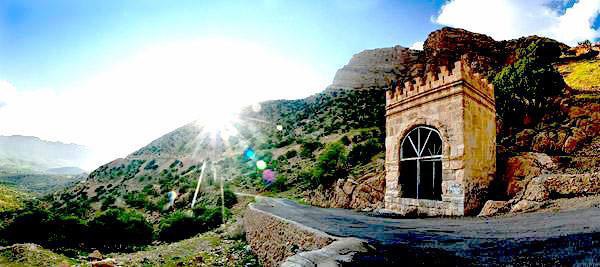Sarpol Zahab
Sarpol Zahab (Kurdish: سهربێڵ زهاو) is one of the cities of Kermanshah province of Iran. The people of this city are Kurds. This Iranian border city was severely damaged during the Iran-Iraq war, but was rebuilt after the war. This city is located at 45 degrees and 52 minutes of east longitude and 34 degrees and 24 degrees of latitude, in the west of the country and at the end of the slope of the Zagros highlands, on the international road of Tehran-Baghdad, known as the Karbala road. This city is the center of Sarpol Zahab county.
Based on the study of its ancient monuments and inscriptions, the city of Sarpol Zahab is one of the most ancient cities in the world, based on the study of its ancient monuments and inscriptions, such as the inscription and epitaph of Anubanini, the king of Lulobis (which is 4800 years old), which is carved on the northeast side of the ever-stable Zagros mountain range. And according to the famous orientalist Rawlinson, it is considered the eighth ancient city in the world. Anubani inscription is considered one of the oldest and, in other words, the first architectural art in Asia. The Biston inscription was carved 2000 years after this inscription was engraved and in many ways it is similar to the Anubanini relief, so it is assumed that the Biston inscription was created by imitating this inscription.
Among other ancient works of Sarpol Zahab city, we can mention the Anubanini Naqsh of Dekan Dawood, Taq Gara, Gabri Castle and dozens of other ancient and historical works. The wide historical span of these ancient works clearly shows the continuity of civilization in this city throughout history.
During its ancient history, Sarpol Zahab has been known by various names, including Patir, which is related to the era of Lulobis and Medes (Patir was the name of the mountain inside the city of Sarpol Zahab during the time of Lulobis, and later it became known as the city, or perhaps as Diakonov in Media history believes that “Batir”, which is the oldest name of Sarpol Zahab, was the name of one of Zoroaster’s ancestors, as well as Helwan, which is more famous than other names. Some consider this name to be derived from the name of the river passing through this city (Alvand).
The Assyrians have mentioned this city as Kalmano. During the Sassanid era, this area was a province named Khosro Shad Firouz. In Arab historical and geographical books, Zahab is written as Zahav and it is introduced as the center of Helwan district. During the Abbasid caliphate, this area was under the rule of Baghdad, but later, except for the Zandiya and Qajar eras (until 1338 AH), which were ruled by the Ottoman kings, it was always a part of Iran. Helwan is an important city of the Sassanids and the 156-year-old capital of the Nazis. “Ibn Khaldun” observed the oldest works of Asian civilization in this city and “Ravilinson” considers it one of the eight ancient cities of the world.
,
The name Sarpol Zahab is due to the fact that there was a bridge over the Helvan Alvand river in this place, which was destroyed in 1345.
The recent earthquake
A severe earthquake in the evening of November 21, 2016, with a magnitude of 7.3 on the Richter scale, shook the provinces of Kermanshah, Ilam, and Kurdistan, and large parts of the west and northwest of the country.
Image: Taqgara, Zahab bridge head
“Thanks to Farshet Fathaliani”
https://t.me/joinchat/AAAAAD7jR1f_09TXsZPR7Q
This post is written by None
